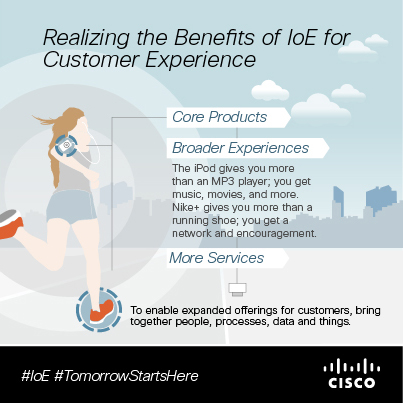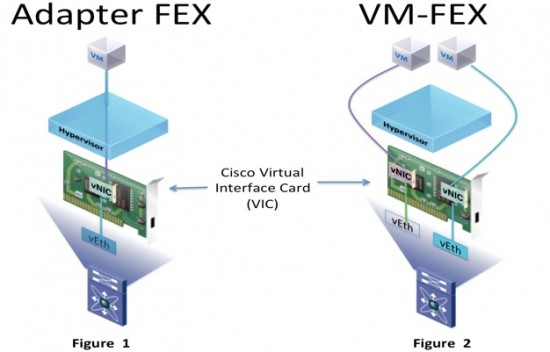We’re entering the age of the Internet of Everything (IoE), which is about connecting the Internet to the physical world (people, process, data, and things). We’re early in the process, with approximately 10 billion devices already connected. By 2020, Cisco projects that this number will reach 50 billion “things.” One of the key areas of impact identified in the Cisco Internet of Everything Economy report, “Embracing the Internet of Everything To Capture Your Share of $14.4 Trillion,” is customer experience. The report estimates that IoE-driven customer experience advances — based on increasing customer lifetime value and growing market share by adding more customers — will drive $3.7 trillion of the estimated $14.4 trillion of IoE Value at Stake globally over the next decade.

IoE is enabling organizations to engage with their customers in whole new ways and to create new business models. IoE is all about making new connections possible: interactions among people, and between people and devices. It’s also about the ability of devices to communicate with each other, with applications, and with digital services, and then empowering those technologies to take action based on these communications.
When more of the world is connected, expect the delivery of your customer experience to shift beyond the boundaries of your current web and mobile sites, and past the walls of your offices and stores. New technologies connected to the Internet — including things like Google Glasses, IP-enabled lightbulbs, new gesture technologies, and sensors — will form the foundation of IoE. However, it is the data stream produced by all of these new connections that will have the greatest impact on your relationship with your customers.
With IoE, you will be better able to build customer loyalty and delight — creating emotional brand connections, personalizing the experience, and targeting offerings based on the data generated by IoE. Just think about what the IoE-powered future might look like across your customer journey.
- Transform the process of building awareness and encouraging purchases,by bringing together data from various sources, including sensors that pick up signals to help anticipate customer needs. Target these customers in real time based on history, location, and activity.
- Apps move from performing cross-brand product comparisons to enabling customers to determine where to find items based on criteria they set, including best price, product ratings, and the most convenient retail location to shop (automatically taking traffic and wait times into consideration).
- Connected vending machines, digital signage, and other surfaces will recognize customers and deliver customized content at the point of need.
- Items will be ordered on — and delivered to — a customer’s mobile phone, wherever it is located.
- Post-sale, connect with the personal side of customers’ lives to help them achieve their goals. This will enable you to add post-sale value to create new revenue streams and drive new insights for innovation. Look for ways to be proactive, anticipate and prevent issues before they happen, or make suggestions that will improve a customer’s life.
- Mobile devices or sensors react to the environment and are set to receive personalized messages placed by you or your customers’ social circles.
- Sensors on clothing monitor customers’ health, enabling them to analyze and collect information about themselves, optimize their personal behaviors, and alert caregivers when there is an issue.
- Connected cars move beyond monitoring an automobile’s performance to collecting data about customers’ driving habits, providing instant insurance quotes, and communicating with things along a route
These capabilities can be offered as services, and the great thing is they can be updated and improved over time. Companies like Nike are already way ahead with products like Nike Fuel. Nike has secured a role in my life around my fitness goals, and given all the history it has collected about me, I am not likely to switch to a competitor anytime soon.
If you want to be in a position to tap in to the potential of IoE, it’s time to get thinking about the role your brand will play in this new world. One of the first steps in designing your customer experience is good information about the needs and trends of your customers. Cisco is helping through primary research such as the Connected Customer Experience Report for Health Care, with more industries to come. Please also follow us on the new Cisco Customer Experience Facebook page and Twitter for updated information.
In Part 2 of this blog series, I’ll provide specific details on how to get started in realizing the benefits of IoE for improving customer experience. In the meantime, I’d love your thoughts on how IoE will redefine customer experience as we know it.
Share:



 By Guest Contributor Sheila Jordan
By Guest Contributor Sheila Jordan I’m excited to mention that next week I’m hosting a
I’m excited to mention that next week I’m hosting a 
 Additionally we’ll discuss how Cisco is delivering a full spectrum or portfolio approach to offering reference architectures that map more closely to the specific VDI use cases. This expanded flexibility and choice is breaking down the CAPEX and operations hurdles many IT organizations face when implementing VDI. We’ll also discuss the best-of-breed technologies we’ve integrated from our solution ecosystem, and how you can take advantage of new reference architectures that help eliminate the guesswork from VDI.
Additionally we’ll discuss how Cisco is delivering a full spectrum or portfolio approach to offering reference architectures that map more closely to the specific VDI use cases. This expanded flexibility and choice is breaking down the CAPEX and operations hurdles many IT organizations face when implementing VDI. We’ll also discuss the best-of-breed technologies we’ve integrated from our solution ecosystem, and how you can take advantage of new reference architectures that help eliminate the guesswork from VDI.

CONNECT WITH US